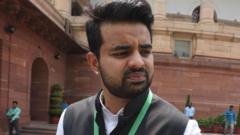A reflection on the genius of Guru Dutt reveals an artistic visionary whose life was marred by internal struggles and tragic circumstances.
Guru Dutt: The Silent Struggles of an Indian Film Icon

Guru Dutt: The Silent Struggles of an Indian Film Icon
Exploring the profound impact and tragic life of the beloved filmmaker, Guru Dutt, as he faces creative ambitions and personal demons.
Guru Dutt, the iconic Indian filmmaker and actor, left an indelible mark on Indian cinema before his untimely death at 39 in 1964. Born on July 9, 1925, in Karnataka, next week celebrates what would have been his birth centenary. Over his career, Dutt created timeless films such as Pyaasa and Kaagaz Ke Phool that still resonate today, yet his emotional battles and mental health struggles have largely remained in the shadows.
Dutt's filmmaking was deeply personal, employing a unique, introspective style that asked audiences to confront the uncomfortable realities of life. His cinematic journey began against a backdrop of financial hardship and family turbulence. After moving to Bengal, he absorbed the local culture, which heavily influenced his work. Entering the Bombay film industry in the 1940s, he initially worked as a choreographer and often juggled multiple jobs to survive, giving birth to his artistic vision amidst the uncertainties of post-independence India.
His breakthrough came when he directed his first film, Baazi, which showcased his talent and marked the beginning of a remarkable career. Life seemed promising when he achieved commercial success with romantic comedies such as Aar-Paar and Mr & Mrs 55 and fell in love with celebrated singer Geeta Roy. However, it was his ambitious project, Pyaasa, that truly defined his legacy. A poignant critique of materialism, this critical and commercial success ultimately became a symbol of his inner turmoil.
Lajmi, Dutt's younger sister, recalls how Pyaasa was his “dream project.” Nonetheless, the pressure of perfection weighed heavily on him, leading to alarming levels of stress, including dependence on alcohol and sleeping pills. At just 31, with Pyaasa close to completion, he attempted suicide, a cry for help that went largely unaddressed due to the stigma surrounding mental health in that era.
Upon release, Pyaasa was met with acclaim, yet Dutt struggled with an overwhelming emptiness despite his achievements. The contrast between his on-screen portrayals of powerful women and his expectations of his wife showcased a complex contradiction in his personal beliefs and relationships.
Undeterred by his earlier setbacks, Dutt embarked on creating Kaagaz Ke Phool, a semi-autobiographical narrative that mirrored his own struggles with creativity and personal relationships. Although recognized as a classic today, its initial failure was devastating for Dutt, leading to a critical turning point in his mental health.
His subsequent works, including Sahib Bibi Aur Ghulam, achieved commercial success but didn’t alleviate his anguish. Following a second suicide attempt, Dutt's struggles with loneliness deepened as he turned to alcohol for comfort. On October 10, 1964, he was found dead, leaving behind a legacy that was both celebrated and overshadowed by his personal tragedies.
In hindsight, many in the industry and film enthusiasts lamented what could have been had Guru Dutt lived longer, as he had the potential to continue transforming Indian cinema with his visionary storytelling and poetic narratives. The poignancy of his life and career remains a testament to the complex interplay of artistic brilliance and profound sorrow.
Yasser Usman is the author of the biography Guru Dutt: An Unfinished Story.
Dutt's filmmaking was deeply personal, employing a unique, introspective style that asked audiences to confront the uncomfortable realities of life. His cinematic journey began against a backdrop of financial hardship and family turbulence. After moving to Bengal, he absorbed the local culture, which heavily influenced his work. Entering the Bombay film industry in the 1940s, he initially worked as a choreographer and often juggled multiple jobs to survive, giving birth to his artistic vision amidst the uncertainties of post-independence India.
His breakthrough came when he directed his first film, Baazi, which showcased his talent and marked the beginning of a remarkable career. Life seemed promising when he achieved commercial success with romantic comedies such as Aar-Paar and Mr & Mrs 55 and fell in love with celebrated singer Geeta Roy. However, it was his ambitious project, Pyaasa, that truly defined his legacy. A poignant critique of materialism, this critical and commercial success ultimately became a symbol of his inner turmoil.
Lajmi, Dutt's younger sister, recalls how Pyaasa was his “dream project.” Nonetheless, the pressure of perfection weighed heavily on him, leading to alarming levels of stress, including dependence on alcohol and sleeping pills. At just 31, with Pyaasa close to completion, he attempted suicide, a cry for help that went largely unaddressed due to the stigma surrounding mental health in that era.
Upon release, Pyaasa was met with acclaim, yet Dutt struggled with an overwhelming emptiness despite his achievements. The contrast between his on-screen portrayals of powerful women and his expectations of his wife showcased a complex contradiction in his personal beliefs and relationships.
Undeterred by his earlier setbacks, Dutt embarked on creating Kaagaz Ke Phool, a semi-autobiographical narrative that mirrored his own struggles with creativity and personal relationships. Although recognized as a classic today, its initial failure was devastating for Dutt, leading to a critical turning point in his mental health.
His subsequent works, including Sahib Bibi Aur Ghulam, achieved commercial success but didn’t alleviate his anguish. Following a second suicide attempt, Dutt's struggles with loneliness deepened as he turned to alcohol for comfort. On October 10, 1964, he was found dead, leaving behind a legacy that was both celebrated and overshadowed by his personal tragedies.
In hindsight, many in the industry and film enthusiasts lamented what could have been had Guru Dutt lived longer, as he had the potential to continue transforming Indian cinema with his visionary storytelling and poetic narratives. The poignancy of his life and career remains a testament to the complex interplay of artistic brilliance and profound sorrow.
Yasser Usman is the author of the biography Guru Dutt: An Unfinished Story.

















